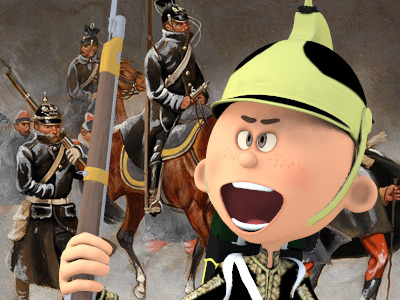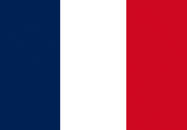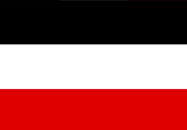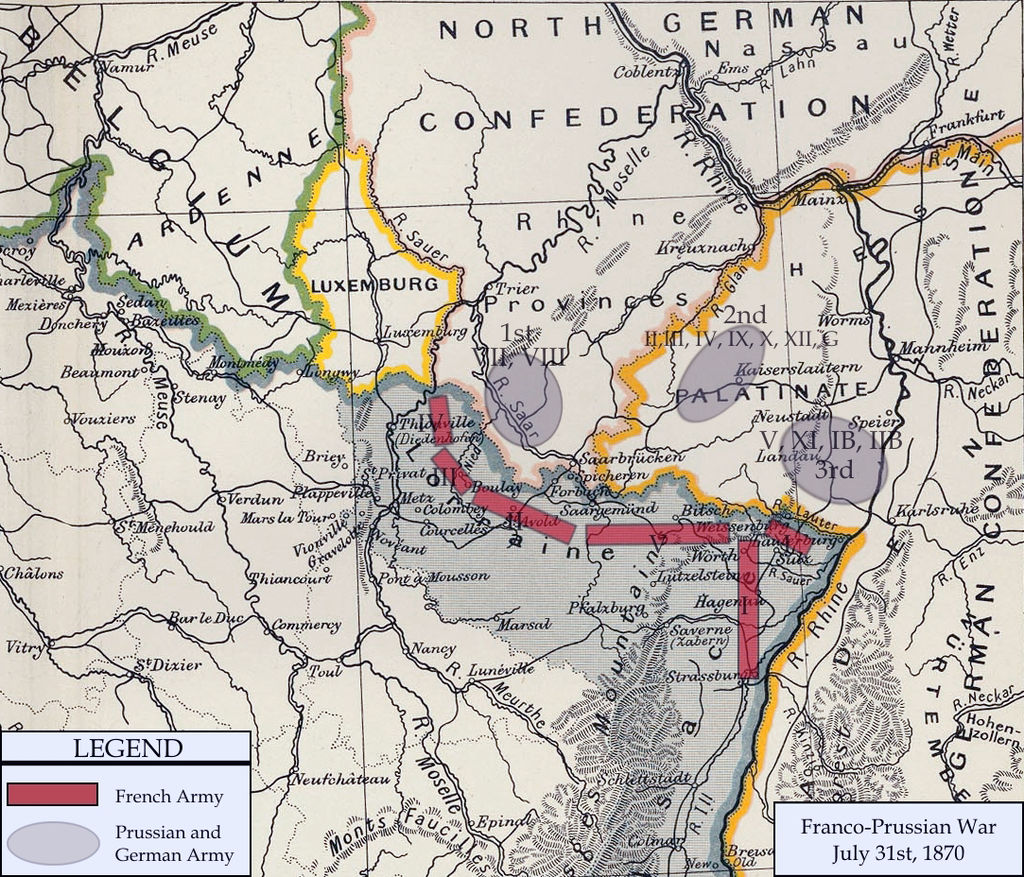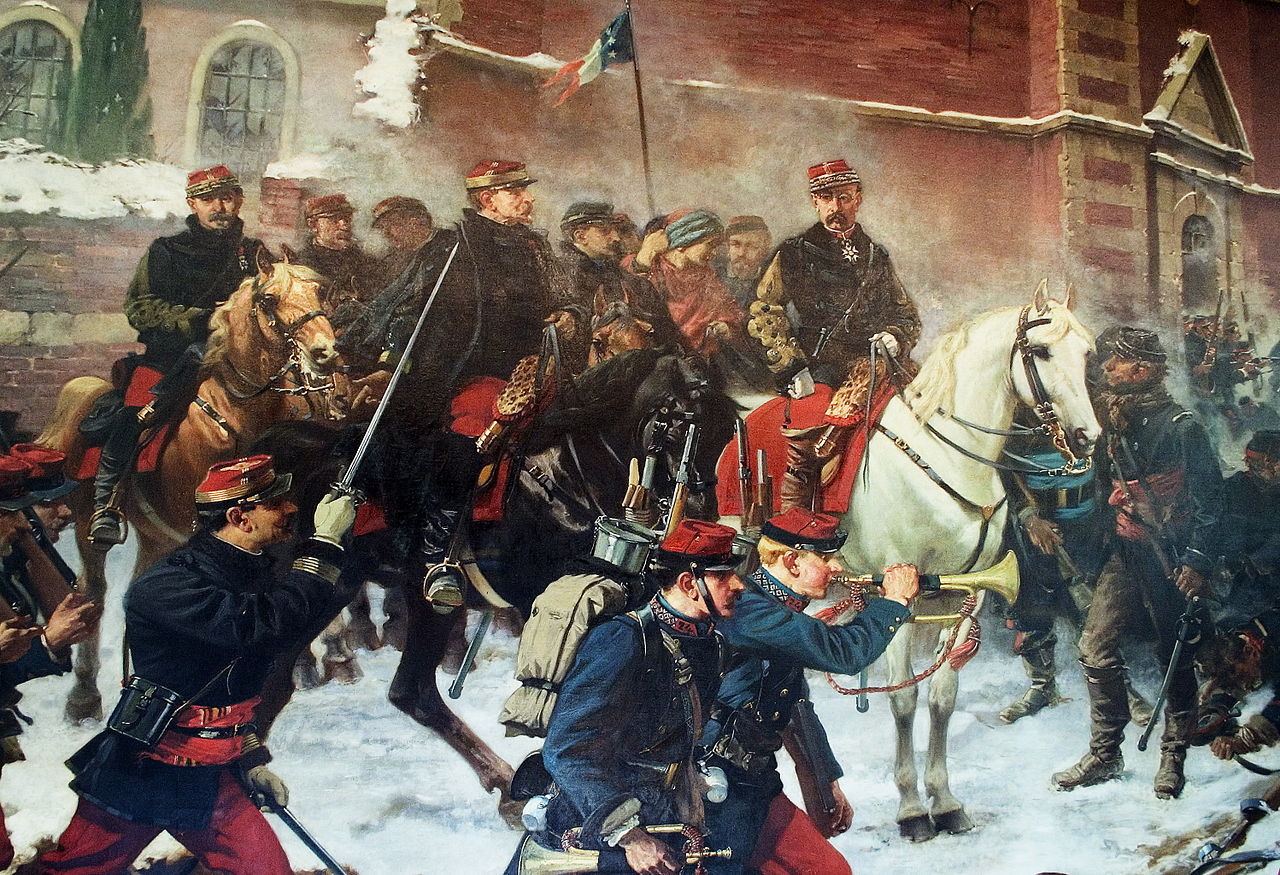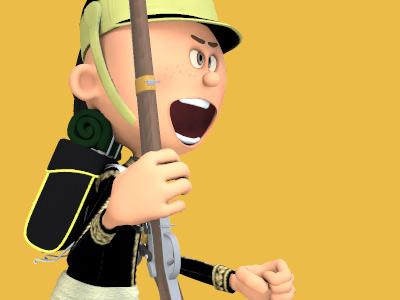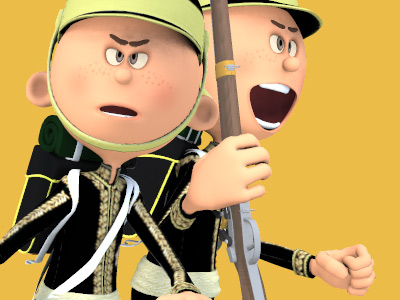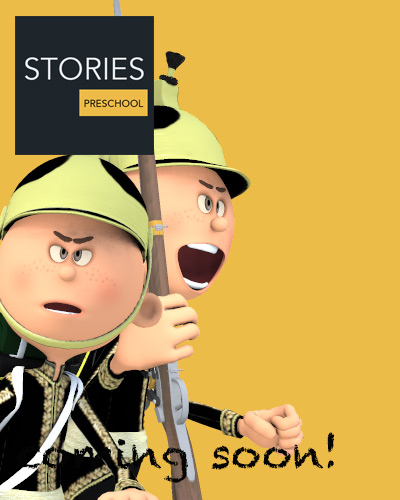Franco-Prussian War (1870 to 1871)
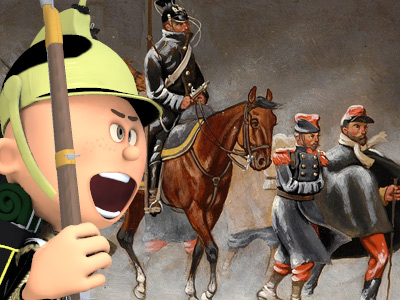
Aftermath
Analysis
The quick German victory over the French stunned neutral observers, many of whom had expected a French victory and most of whom had expected a long war. The strategic advantages possessed by the Germans were not appreciated outside Germany until after hostilities had ceased. Other countries quickly discerned the advantages given to the Germans by their military system, and adopted many of their innovations, particularly the General Staff, universal conscription and highly detailed mobilization systems.
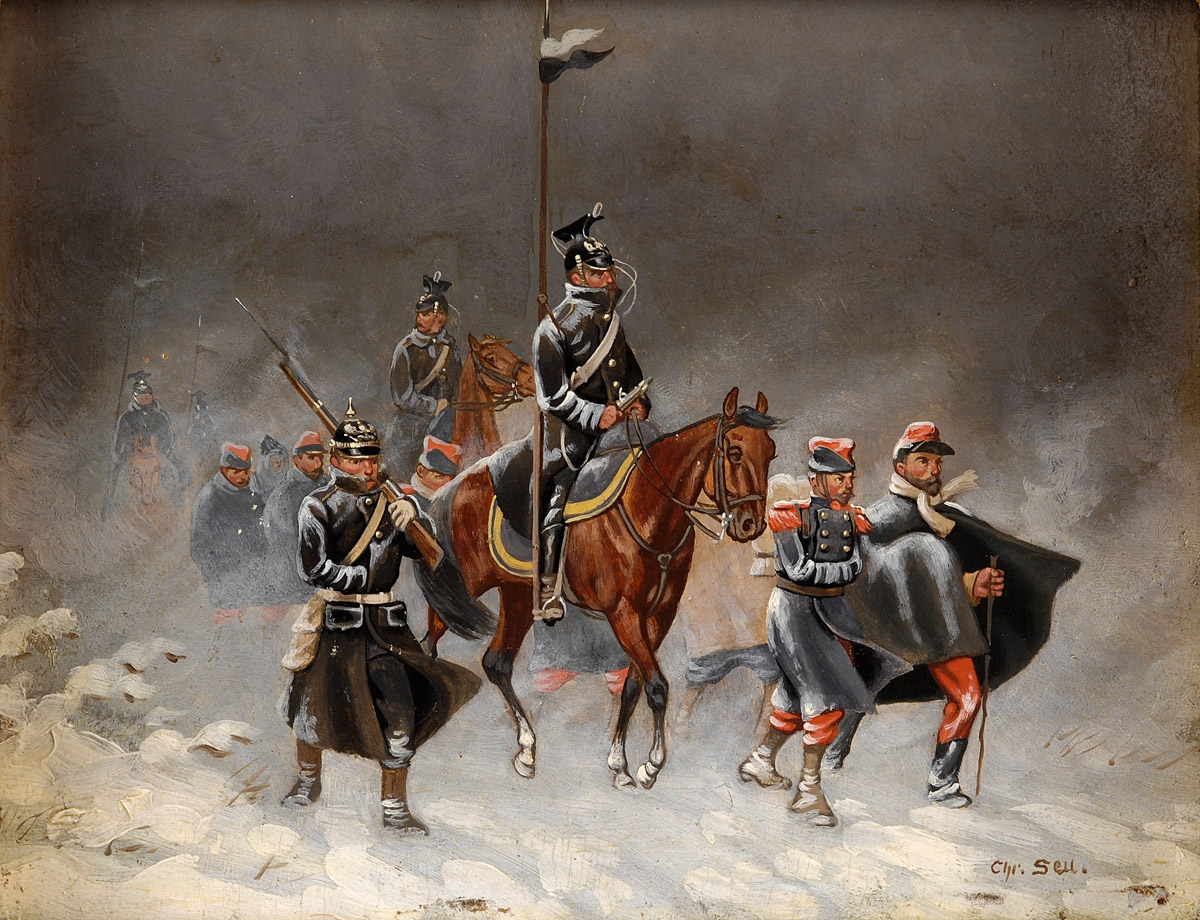
German uhlans and an infantryman escorting captured French soldiers

German uhlans and an infantryman escorting captured French soldiers
( Click image to enlarge)
The Prussian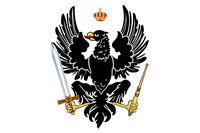 The Kingdom of Prussia was a German kingdom that constituted the state of Prussia between 1701 and 1918. It was the driving force behind the unification of Germany in 1871 and was the leading state of the German Empire until its dissolution in 1918. Although it took its name from the region called Prussia, it was based in the Margraviate of Brandenburg. Its capital was Berlin. General Staff developed by Moltke proved to be extremely effective, in contrast to the traditional French school. This was in large part due to the fact that the Prussian General Staff was created to study previous Prussian operations and learn to avoid mistakes. The structure also greatly strengthened Moltke's ability to control large formations spread out over significant distances. The Chief of the General Staff, effectively the commander in chief of the Prussian army, was independent of the minister of war and answered only to the monarch. The French
The Kingdom of Prussia was a German kingdom that constituted the state of Prussia between 1701 and 1918. It was the driving force behind the unification of Germany in 1871 and was the leading state of the German Empire until its dissolution in 1918. Although it took its name from the region called Prussia, it was based in the Margraviate of Brandenburg. Its capital was Berlin. General Staff developed by Moltke proved to be extremely effective, in contrast to the traditional French school. This was in large part due to the fact that the Prussian General Staff was created to study previous Prussian operations and learn to avoid mistakes. The structure also greatly strengthened Moltke's ability to control large formations spread out over significant distances. The Chief of the General Staff, effectively the commander in chief of the Prussian army, was independent of the minister of war and answered only to the monarch. The French Second French Empire was the 18-year Imperial Bonapartist regime of Napoleon III from 14 January 1852 to 27 October 1870. The Second Empire is given high credit for the rebuilding of Paris with broad boulevards, striking public buildings, and elegant residential districts for upscale Parisians. In international policy, Napoleon III tried to emulate his uncle Napoleon I, engaging in numerous imperial ventures around the world as well as several wars in Europe. General Staff—along with those of every other European military—was little better than a collection of assistants for the line commanders. This disorganization hampered the French commanders' ability to exercise control of their forces.
Second French Empire was the 18-year Imperial Bonapartist regime of Napoleon III from 14 January 1852 to 27 October 1870. The Second Empire is given high credit for the rebuilding of Paris with broad boulevards, striking public buildings, and elegant residential districts for upscale Parisians. In international policy, Napoleon III tried to emulate his uncle Napoleon I, engaging in numerous imperial ventures around the world as well as several wars in Europe. General Staff—along with those of every other European military—was little better than a collection of assistants for the line commanders. This disorganization hampered the French commanders' ability to exercise control of their forces.
In addition, the Prussian military education system was superior to the French model; Prussian staff officers were trained to exhibit initiative and independent thinking. Indeed, this was Moltke's expectation. The French, meanwhile, suffered from an education and promotion system that stifled intellectual development. According to the military historian Dallas Irvine, the system "was almost completely effective in excluding the army's brain power from the staff and high command. To the resulting lack of intelligence at the top can be ascribed all the inexcusable defects of French military policy."
Albrecht von Roon, the Prussian Minister of War from 1859 to 1873, put into effect a series of reforms of the Prussian military system in the 1860s. Among these were two major reforms that substantially increased the military power of Germany. The first was a reorganization of the army that integrated the regular army and the Landwehr reserves. The second was the provision for the conscription of every male Prussian of military age in the event of mobilization. Thus, despite the population of France being greater than the population of all of the German states that participated in the war, the Germans mobilized more soldiers for battle.
At the outset of the Franco-Prussian War, 462,000 German soldiers concentrated on the French frontier while only 270,000 French soldiers could be moved to face them, the French army having lost 100,000 stragglers before a shot was fired through poor planning and administration. This was partly due to the peacetime organisations of the armies. Each Prussian Corps was based within a Kreis (literally "circle") around the chief city in an area. Reservists rarely lived more than a day's travel from their regiment's depot. By contrast, French regiments generally served far from their depots, which in turn were not in the areas of France from which their soldiers were drawn. Reservists often faced several days' journey to report to their depots, and then another long journey to join their regiments. Large numbers of reservists choked railway stations, vainly seeking rations and orders.
The effect of these differences was accentuated by the pre-war preparations. The Prussian General Staff had drawn up minutely detailed mobilization plans using the railway system, which in turn had been partly laid out in response to recommendations of a Railway Section within the General Staff. The French railway system, with multiple competing companies, had developed purely from commercial pressures and many journeys to the front in Alsace and Lorraine involved long diversions and frequent changes between trains. Furthermore, no system had been put in place for military control of the railways, and officers simply commandeered trains as they saw fit. Rail sidings and marshalling yards became choked with loaded wagons, with nobody responsible for unloading them or directing them to the destination.
Although Austria-Hungary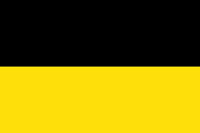 Austria-Hungary, often referred to as the Austro-Hungarian Empire, the Dual Monarchy, or Austria, was a constitutional monarchy and great power in Central Europe between 1867 and 1918. Austria-Hungary was one of the Central Powers in World War I, which began with an Austro-Hungarian war declaration on the Kingdom of Serbia on 28 July 1914. and Denmark had both wished to avenge their recent military defeats against Prussia, they chose not to intervene in the war due to a lack of confidence in the French. Napoleon III also failed to cultivate alliances with the Russian Empire
Austria-Hungary, often referred to as the Austro-Hungarian Empire, the Dual Monarchy, or Austria, was a constitutional monarchy and great power in Central Europe between 1867 and 1918. Austria-Hungary was one of the Central Powers in World War I, which began with an Austro-Hungarian war declaration on the Kingdom of Serbia on 28 July 1914. and Denmark had both wished to avenge their recent military defeats against Prussia, they chose not to intervene in the war due to a lack of confidence in the French. Napoleon III also failed to cultivate alliances with the Russian Empire Russian Empire was an empire and the final period of the Russian monarchy from 1721 to 1917, ruling across large parts of Eurasia. The rise of the Russian Empire coincided with the decline of neighbouring rival powers: the Swedish Empire, the Polish–Lithuanian Commonwealth, Qajar Iran, the Ottoman Empire, and Qing China. Russia remains the third-largest empire in history, surpassed only by the British Empire and the Mongol Empire. and the United Kingdom
Russian Empire was an empire and the final period of the Russian monarchy from 1721 to 1917, ruling across large parts of Eurasia. The rise of the Russian Empire coincided with the decline of neighbouring rival powers: the Swedish Empire, the Polish–Lithuanian Commonwealth, Qajar Iran, the Ottoman Empire, and Qing China. Russia remains the third-largest empire in history, surpassed only by the British Empire and the Mongol Empire. and the United Kingdom The British Empire, was composed of the dominions, colonies, protectorates, mandates, and other territories ruled or administered by the United Kingdom and its predecessor states. At its height it was the largest empire in history and, for over a century, was the foremost global power. By the start of the 20th century, Germany and the United States had begun to challenge Britain's economic lead., partially due to the diplomatic efforts of the Prussian chancellor Otto von Bismarck, and thus faced the German states alone.
The British Empire, was composed of the dominions, colonies, protectorates, mandates, and other territories ruled or administered by the United Kingdom and its predecessor states. At its height it was the largest empire in history and, for over a century, was the foremost global power. By the start of the 20th century, Germany and the United States had begun to challenge Britain's economic lead., partially due to the diplomatic efforts of the Prussian chancellor Otto von Bismarck, and thus faced the German states alone.
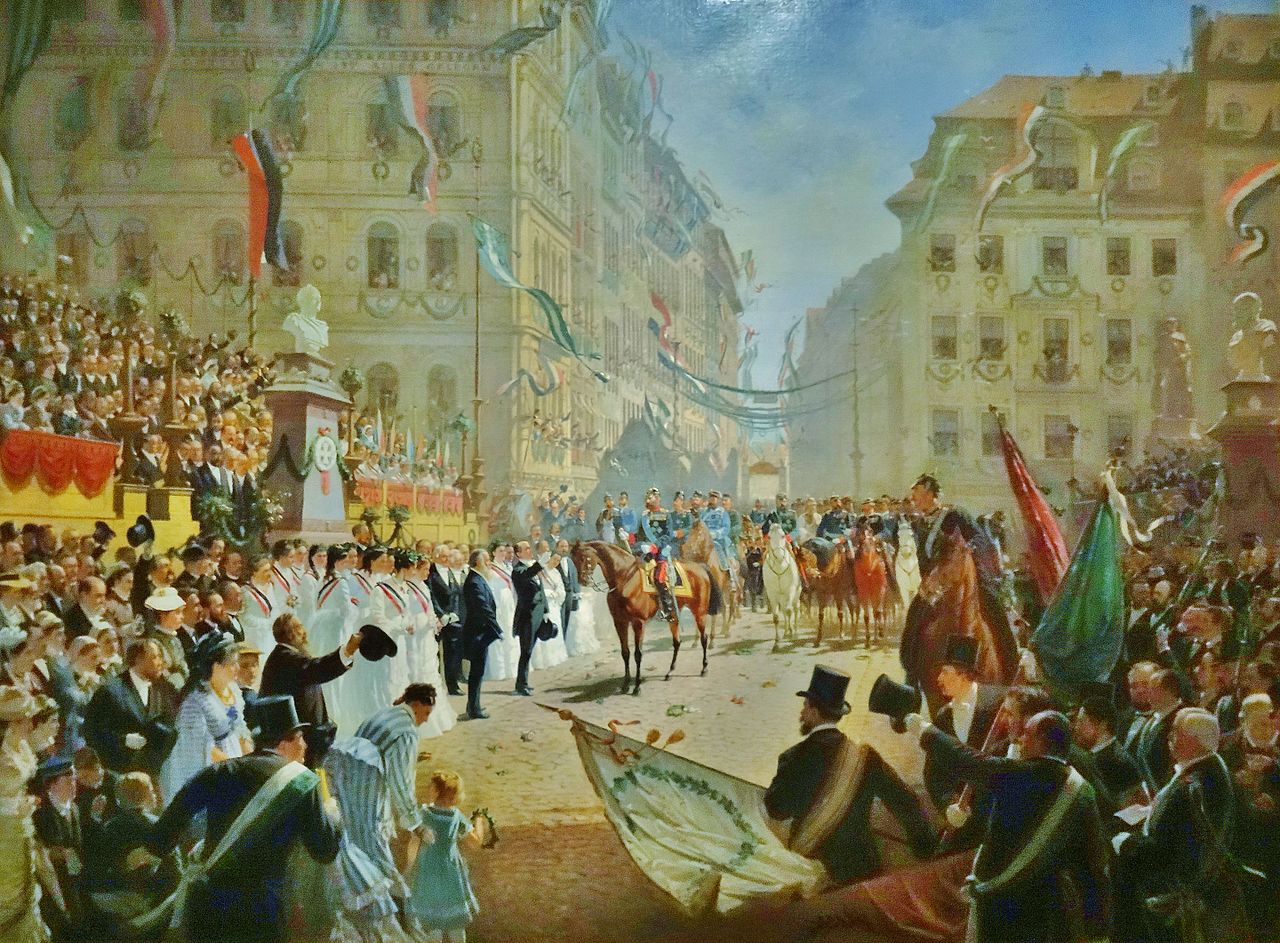
The Prince Albert of Saxony is celebrating the victory over France in Dresden, 11th July 1871

The Prince Albert of Saxony is celebrating the victory over France in Dresden, 11th July 1871
( Click image to enlarge)
The French breech-loading rifle, the Chassepot, had a far longer range than the German needle gun; 1,500 yards (1,400 m) compared to 600 yd (550 m). The French also had an early machine-gun type weapon, the mitrailleuse, which could fire its thirty-seven barrels at a range of around 1,200 yd (1,100 m). It was developed in such secrecy that little training with the weapon had occurred, leaving French gunners with no experience; the gun was treated like artillery and in this role it was ineffective. Worse still, once the small number of soldiers who had been trained how to use the new weapon became casualties, there were no replacements who knew how to operate the mitrailleuse.
The French were equipped with bronze, rifled muzzle-loading artillery, while the Prussians used new steel breech-loading guns, which had a far longer range and a faster rate of fire. Prussian gunners strove for a high rate of fire, which was discouraged in the French army in the belief that it wasted ammunition. In addition, the Prussian artillery batteries had 30% more guns than their French counterparts. The Prussian guns typically opened fire at a range of 2–3 kilometres (1.2–1.9 mi), beyond the range of French artillery or the Chassepot rifle. The Prussian batteries could thus destroy French artillery with impunity, before being moved forward to directly support infantry attacks.
Effects on Military Thought
The events of the Franco-Prussian War had great influence on military thinking over the next forty years. Lessons drawn from the war included the need for a general staff system, the scale and duration of future wars and the tactical use of artillery and cavalry. The bold use of artillery by the Prussians, to silence French guns at long range and then to directly support infantry attacks at close range, proved to be superior to the defensive doctrine employed by French gunners. The Prussian tactics were adopted by European armies by 1914, exemplified in the French 75, an artillery piece optimised to provide direct fire support to advancing infantry. Most European armies ignored the evidence of the Russo-Japanese War of 1904–05 which suggested that infantry armed with new smokeless-powder rifles could engage gun crews effectively. This forced gunners to fire at longer range using indirect fire, usually from a position of cover.
At the Battle of Mars-la-Tours, the Prussian 12th Cavalry Brigade, commanded by General Adalbert von Bredow, conducted a charge against a French artillery battery. The attack was a costly success and came to be known as "von Bredow's Death Ride", which was held to prove that cavalry charges could still prevail on the battlefield. Use of traditional cavalry on the battlefields of 1914 proved to be disastrous, due to accurate, long-range rifle fire, machine-guns and artillery. Von Bredow's attack had succeeded only because of an unusually effective artillery bombardment just before the charge, along with favorable terrain that masked his approach.
HISTORY
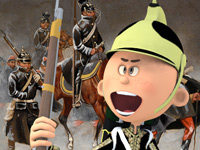
RESOURCES
This article uses material from the Wikipedia article "Franco-Prussian War", which is released under the Creative Commons Attribution-Share-Alike License 3.0.
© Stories Preschool. All Rights Reserved.
